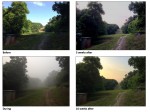
Monday, September 25th, 2017
Forest fires in Southeast Asia during the El Niño droughts of 2015 caused considerable disruption to the biodiversity of the region due to the smoke-induced haze they created, according to new research published in the Environmental Research Letters journal and led by Benjamin Lee at the University of Kent and the National Parks Board in
Thursday, August 13th, 2015
August 13, 2015 — Conservation organisations and space agencies are being called on to join forces to decide how changes in biodiversity can be monitored globally. What, exactly, should be measured by satellites?
There are no upcoming events.
